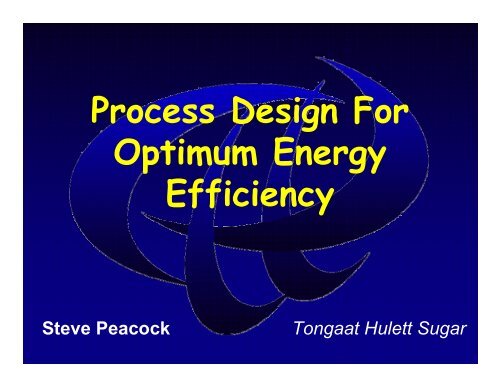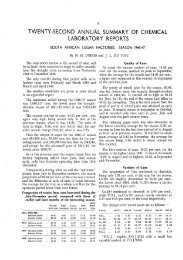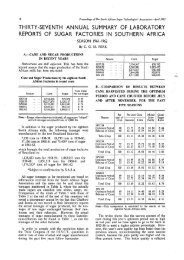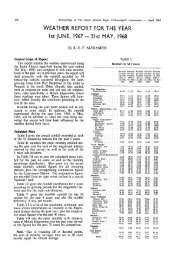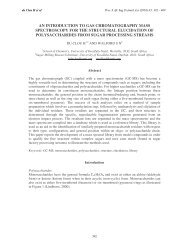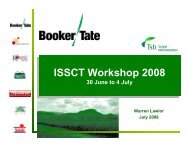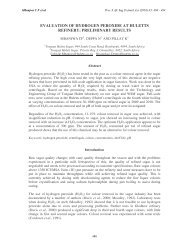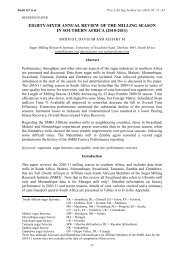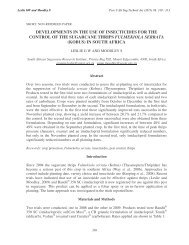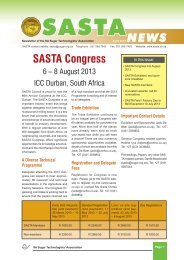Process Design For Optimum Energy Efficiency - sasta
Process Design For Optimum Energy Efficiency - sasta
Process Design For Optimum Energy Efficiency - sasta
Create successful ePaper yourself
Turn your PDF publications into a flip-book with our unique Google optimized e-Paper software.
<strong>Process</strong> <strong>Design</strong> <strong>For</strong><br />
<strong>Optimum</strong> <strong>Energy</strong><br />
<strong>Efficiency</strong><br />
Steve Peacock<br />
Tongaat Hulett Sugar
INTRODUCTION<br />
• The average SA sugar factory has a bagasse<br />
supply capable of supporting a steam on cane<br />
of just under 60%<br />
– Assuming no bagasse export
ML<br />
KM<br />
PG<br />
UF<br />
FX<br />
AK<br />
DL<br />
MS<br />
GH<br />
NB<br />
UC<br />
ES<br />
SZ<br />
UK<br />
Industry<br />
70<br />
68<br />
66<br />
64<br />
62<br />
60<br />
58<br />
56<br />
54<br />
52<br />
50<br />
2007 Data<br />
Assuming HP Steam to Bagasse Ratio of 2,0<br />
HP Steam % Cane
INTRODUCTION<br />
• Traditional factory design focused on achieving<br />
a fuel balance :<br />
– Minimising the purchase of supplementary fuel (coal)<br />
– Avoiding the generation of an bagasse surplus<br />
• Hiding it under the GM’s office carpet<br />
• Giving it to the staff at Christmas, etc.<br />
• The emphasis on co-product production and<br />
energy export has changed industry thinking
INTRODUCTION<br />
• Traditional steam % cane values ranged<br />
between 55 and 60%<br />
• The current energy focus has lowered the target<br />
values. The achievable lower limit is currently<br />
estimated to be :<br />
– Reid & Rein (1983) – 37%<br />
– Singh et al. (1997) – 49% (with back-end refinery)<br />
– Broadfoot (2001) – 33%<br />
– Reid (2006) – 35%<br />
– Sharma & Peacock (2008) – 38%
INTRODUCTION<br />
• We need to distinguish between HP steam %<br />
cane and process steam % cane<br />
– There can be a substantial difference<br />
– Low values quoted in the literature refer to process<br />
steam only (at steady-state)<br />
• <strong>For</strong> a non-cogeneration factory, HP steam %<br />
cane values of between 45% and 50% are<br />
readily achievable under SA conditions
INTRODUCTION<br />
• The lower steam to cane ratios require a<br />
decrease in imbibition rate below SA values<br />
– The sacrifice of sugar recovery in the interests of<br />
energy efficiency is currently looking good<br />
(Details to come)
INTRODUCTION<br />
• There is generally no reason why a sugar mill<br />
should have to continually consume coal during<br />
normal operation<br />
– Unless it is carrying out substantial:<br />
• Export of bagasse<br />
• Export of energy (steam, electrical power)<br />
• Supply of utilities to back-end operations (refinery, ethanol<br />
plant, etc.)
INTRODUCTION<br />
• However, increasing energy efficiency costs<br />
money<br />
– Standard factory designs are cheap, but can lead to high<br />
operating expenses for supplementary fuel<br />
– <strong>Energy</strong>-efficiency generally requires more equipment<br />
(particularly heating surface in heaters & evaporators)<br />
• There is a trade-off between capital cost and<br />
operating expenses that needs to be investigated
Reid, M.J. (2006), “Why do we continue to burn so much coal?”, SASTA, 80, 353-363.<br />
kg coal / ton cane
INTRODUCTION<br />
• The SA industry continues to burn substantial<br />
quantities of coal. This means that either :<br />
– The trade-off has been investigated by all mills and a<br />
conscious decision made to prefer operating expenditure to<br />
capital investment (yeah, right), or<br />
– Some of us haven’t bothered to do anything while the cost<br />
of coal has dramatically increased
ENERGY<br />
EFFICIENCY
ENERGY EFFICIENCY<br />
• The principles of process energy efficiency in a<br />
sugar factory are fairly simple :<br />
– Reduce the amount of steam / vapour consumption<br />
– Make use of lower-grade vapours for heating purposes<br />
• The basic principle of vapour bleeding<br />
– If 1 ton of evaporator bleed vapour from effect “n” in<br />
an “N”-effect evaporator station is substituted for<br />
exhaust steam, then the saving in exhaust steam<br />
consumption is “n/N” tons.
ENERGY EFFICIENCY<br />
• The principles of process energy efficiency in a<br />
sugar factory are fairly simple :<br />
– Reduce the amount of steam / vapour consumption<br />
– Make use of lower-grade vapours for heating purposes<br />
• The basic principle of vapour bleeding<br />
– If 1 ton of evaporator bleed vapour from effect “n” in<br />
an “N”-effect evaporator station is substituted for<br />
exhaust steam, then the saving in exhaust steam<br />
consumption is “n/N” tons.
ENERGY EFFICIENCY<br />
• The evaporator station is the heart of the sugar<br />
factory energy system<br />
– It is the largest consumer of process steam<br />
– It provides the vapour bleed streams used for the other<br />
heating duties in the factory<br />
– Understanding the behaviour of the evaporator station is<br />
key to energy efficiency<br />
– Much like a cornered sugar technologist - It will only take a<br />
limited amount of abuse before fighting back
Assuming that 1 ton of steam evaporates 1 ton of water
Exhaust IN = Vapour Bleeds OUT<br />
(Including vapour to the condenser)
ENERGY EFFICIENCY<br />
• Saving energy by reducing steam / vapour<br />
demand is a no-brainer...<br />
– Reducing the bleed flow reduces the exhaust demand<br />
• How does the use of low-grade bleeds improve<br />
energy efficiency ?
P1<br />
P2<br />
P3<br />
P4
ENERGY EFFICIENCY<br />
• Moving vapour demand to a lower-grade supply<br />
of vapour (e.g. from V1 to V2) reduces the<br />
residual amount of evaporation that needs to<br />
be done in the rest of the tail<br />
– Ultimately, this reduces the amount of final effect vapour<br />
entering the condenser “x”
Moving bleed from V1 to V2 reduces “x”, which reduces the exhaust steam demand<br />
Exhaust IN = Vapour Bleeds OUT<br />
(Including vapour to the condenser)
ENERGY EFFICIENCY<br />
• <strong>Energy</strong> efficiency reduces to one simple rule ...<br />
• The only way to increase process energy<br />
efficiency in a sugar factory is to reduce steam /<br />
vapour demand :<br />
– This includes vapour “demand” by the condenser, which is<br />
reduced by optimal design of the evaporator station & bleed<br />
vapour configuration<br />
– But there are limits !
ENERGY EFFICIENCY<br />
• You cannot evaporate more water from the juice<br />
than you can evaporate from the juice (duh !)<br />
– The juice can only go to 65 – 70% brix<br />
– It is easy to over-concentrate the juice by moving most of<br />
your heating to low-grade vapour supplies (V2, V3 & V4)<br />
• In this case, there is no vapour left for the final effect<br />
condenser (x = 0)
0<br />
Exhaust IN = Vapour Bleeds OUT<br />
(Zero vapour to the condenser = maximum energy efficiency)
ENERGY EFFICIENCY<br />
• With zero vapour flow to the condenser :<br />
– No energy efficiency improvement can be obtained by<br />
moving vapour bleeds around<br />
– Control of the evaporation from the juice becomes more<br />
difficult & sensitive to the bleed flow rates (see Sharma &<br />
Peacock, 2008)<br />
– Any increase in bleed flows will require an equal increase in<br />
exhaust steam consumption<br />
• So you can meet it by letting down exhaust steam
PROCESS<br />
DESIGN FOR<br />
ENERGY<br />
EFFICIENCY
PROCESS DESIGN<br />
• Several basic process design options are<br />
available for improving energy efficiency<br />
– Many are described here, with simple cost-benefit<br />
analyses for some of the options<br />
– Several others are available<br />
– In this investigation, no attempt has been made to<br />
carry out structural changes to the operation, such as<br />
• The boiling scheme<br />
• The quality of sugar produced<br />
•Etc, etc
PROCESS DESIGN<br />
• <strong>Process</strong> design should not attempt to “design in”<br />
operational behaviour, such as :<br />
– Improvements in A-exhaustion<br />
– Reductions in water usage, etc<br />
• This should only be done where such<br />
improvements are easily achieved as a result of<br />
equipment or process changes (and can thus be<br />
“guaranteed”)
SIMPLE OPTIONS<br />
• A number of simple (& obvious) options exist for<br />
increasing energy efficiency. These include :<br />
– Increasing the number of evaporator effects<br />
– Two-stage mixed juice heating using V2 & V1<br />
– Two-stage clear juice heating using V1 & exhaust<br />
– Using V2 vapour for diffuser heating<br />
– Using V2 vapour for pan boiling<br />
– Recycling clarifier mud to the diffuser
SIMPLE OPTIONS<br />
• Increasing the number of evaporator effects<br />
– While there is still final effect vapour passing to the<br />
condenser, this will reduce the exhaust steam<br />
demand of the evaporator station<br />
– This happens because the “remaining” evaporation of<br />
the juice (after the bleed vapour has been withdrawn)<br />
is carried out in more effects. This reduces the flow “x”<br />
of vapour to the condenser
SIMPLE OPTIONS<br />
• Increasing the number of evaporator effects<br />
– Requires the installation of additional surface area<br />
– Quintuple effect evaporator stations are economically<br />
viable. Increasing the number of effects beyond this<br />
does not generally appear to be<br />
– There are other ways of reducing the flow of vapour to<br />
the condenser
SIMPLE OPTIONS<br />
• Use of V2 vapour for diffuser heating, juice<br />
heating and pan boiling<br />
– Leads to substantial energy efficiency benefits<br />
– Requires the installation of additional surface area in<br />
the evaporator station to supply V2 bleed vapour at a<br />
suitable pressure for factory use<br />
• Typically 120 - 130 kPa(a)
SIMPLE OPTIONS<br />
• The use of V2 vapour for pan boiling<br />
– Is relatively simple in continuous pans, which can<br />
typically operate at sub-atmospheric calandria<br />
pressures<br />
– Use in batch pans is facilitated by the use of pan<br />
stirrers to assist circulation<br />
– Unstirred pans may “lose” some of their effective<br />
volumetric capacity if they are not designed for good<br />
circulation at lower vapour supply pressures
SIMPLE OPTIONS<br />
• No cost-benefit analysis has been carried out<br />
for these options<br />
– They have already been implemented in THS mills<br />
– They typically have extremely good economic returns<br />
and are fairly obvious and widespread
MORE<br />
“ADVANCED”<br />
OPTIONS
ADVANCED OPTIONS<br />
• Using clear juice in the remelter & pans<br />
– Clear juice is used as a substitute for water<br />
– The juice is now evaporated in single effect pan<br />
boiling rather than in a multiple effect evaporator<br />
station, however:<br />
• You were going to add water anyway<br />
• The juice used on the pan floor now bypasses the<br />
evaporator station<br />
– A disadvantage is that it reduces the amount of<br />
evaporation to be done<br />
• There is now less water in the juice available for<br />
vapour bleed production
4<br />
V5 Vapour<br />
To Final Effect<br />
Evaporator<br />
Clear<br />
Juice<br />
2<br />
Clear Juice<br />
Flash Cooler<br />
Water<br />
5<br />
3<br />
B- & C-<br />
Sugars<br />
1<br />
Remelter<br />
7<br />
Remelt<br />
BIC<br />
TIC<br />
Steam<br />
6
ADVANCED OPTIONS<br />
• Using clear juice in the remelter & pans<br />
– Using clear juice instead of movement water in the A-<br />
pans reduces the effective “pan factor”<br />
• Pan factor is the tonnage of steam used to evaporate<br />
each ton of water during pan boiling (typically 130%)<br />
– Clear juice can also be used for preparing B-<br />
magma and in the B-seed pans<br />
– Reduces steam / vapour demand through direct<br />
reduction as well as impact on condenser losses
ADVANCED OPTIONS<br />
• Using clear juice in the remelter and pans<br />
– Reduces HP steam % cane by 1% - 3%<br />
– Has a very low capital cost implication (estimated to<br />
be between R 1 million and R 2,5 million)<br />
• Piping costs<br />
• Clear juice flash cooler<br />
• Instrumentation<br />
– Payback period between 1 and 2 years
ADVANCED OPTIONS<br />
• Direct contact press water heating<br />
– Heating carried out using low grade V3 vapour<br />
– Direct contact heating has a low capital cost<br />
– Water addition into the end of the diffuser has zero<br />
effect on energy efficiency<br />
• It effectively acts like extra imbibition<br />
– Reduces condenser losses
ADVANCED OPTIONS<br />
• Direct contact press water heating<br />
– Reduces HP steam % cane by around 1%<br />
– Has reasonably low capital cost (estimated to be<br />
between R 2,5 million and R 3,5 million)<br />
• Piping costs<br />
• Direct contact heat exchanger<br />
• Instrumentation<br />
– Payback period around 2½ years
ADVANCED OPTIONS<br />
• Three-stage mixed juice heating<br />
– Mixed juice heating is generally carried out<br />
using V1 vapour or a combination of V1 and<br />
V2 vapour (two-stage heating)<br />
– <strong>Energy</strong> efficiency can be improved by adding<br />
a third (primary) stage using V3 vapour<br />
– Reduces condenser losses
ADVANCED OPTIONS<br />
• Three-stage mixed juice heating<br />
– Reduces HP steam % cane by 1% - 2%<br />
– Fairly high capital cost (estimated to be<br />
between R 8 million and R 10 million)<br />
• Shell and tube heat exchanger/s<br />
• Piping costs<br />
• Upgrade of mixed juice pumps<br />
– Payback period between 4 and 7 years
ADVANCED OPTIONS<br />
• Four-stage mixed juice heating<br />
– Following on from three-stage heating,<br />
energy efficiency can be further improved by<br />
adding a fourth stage using V4 vapour<br />
– Only has real potential in a factory with a<br />
milling tandem, or where the draft juice<br />
temperature from the diffuser is reduced<br />
– Reduces condenser losses
ADVANCED OPTIONS<br />
• Four-stage mixed juice heating<br />
– Reduces HP steam % cane by less than 1% for a<br />
diffuser factory<br />
– Fairly high capital cost (estimated to be between R 6<br />
million and R 8 million)<br />
• Shell and tube heat exchanger/s<br />
• Piping costs<br />
• Upgrade of mixed juice pumps<br />
– Payback period around 6 or 7 years
ADVANCED OPTIONS<br />
• Using V3 & V4 for juice heating<br />
– May require evaporator station modifications<br />
or the installation of additional surface area in<br />
order to boost the pressure of the V3 or V4<br />
bleed streams<br />
• Depends on the existing evaporator station<br />
configuration<br />
– This will obviously increase the capital cost
ADVANCED OPTIONS<br />
• Using V3 vapour for pan boiling<br />
– Probably only feasible for continuous pans,<br />
due to the low vapour supply pressure<br />
– Requires evaporator station modifications<br />
(and probably more surface area) to supply<br />
suitable quantities of V3 vapour to the pan<br />
floor at an adequate pressure
ADVANCED OPTIONS<br />
• Using V3 vapour for pan boiling<br />
– Will essentially eliminate the flow of final<br />
effect vapour to the condenser, making<br />
control of the evaporator station difficult<br />
– Only quadruple effect evaporator station<br />
required (with a 5 th effect flash vessel for<br />
syrup cooling purposes)<br />
– Involves a degree of technical risk
V1 Bleed V2 Bleed<br />
V3 Bleed V4 Bleed<br />
Final Effect<br />
Vapour<br />
First<br />
Effect<br />
Second<br />
Effect<br />
Third<br />
Effect<br />
Fourth<br />
Effect<br />
Fifth<br />
Effect<br />
(Flash<br />
Vessel)<br />
Exhaust<br />
Steam<br />
Clear Juice<br />
Syrup
ADVANCED OPTIONS<br />
• Using V3 vapour for pan boiling<br />
– Reduces HP steam % cane by just under 2%<br />
– Fairly high capital cost (estimated to be<br />
between R 16 million and R 20 million)<br />
• Evaporator station modifications & extra capacity<br />
• Piping costs<br />
– Payback period around 7 years
ADVANCED OPTIONS<br />
• Electrification of turbine drives<br />
– Turbines generate substantial quantities of<br />
exhaust steam<br />
– This may limit the ability of a factory to reduce<br />
exhaust steam consumption<br />
– Below a certain point, the turbines will<br />
generate more exhaust than the factory<br />
consumes, leading to blow-off
ADVANCED OPTIONS<br />
• Electrification of turbine drives<br />
– This leads to unnecessary HP steam<br />
production to drive the turbines and to loss of<br />
high quality boiler feed water through exhaust<br />
blow-off
ADVANCED OPTIONS<br />
• Electrification of turbine drives<br />
– Replacement of knife, shredder, mill &<br />
pressure feeder turbine drives with electric<br />
motors will result in HP steam savings<br />
– This is because electric power generated<br />
using a turbo-alternator uses around half the<br />
steam of motive power generated using a<br />
standard sugar industry turbine
ADVANCED OPTIONS<br />
• Electrification of turbine drives<br />
– Reasonably high capital cost (estimated to be<br />
between R 8 million and R 20 million)<br />
• Electric motors<br />
• Switchgear, transformers, etc.<br />
– Payback period between 4 and 5 years
ADVANCED OPTIONS<br />
• Further energy savings can only be achieved<br />
through direct reductions in steam / vapour<br />
consumption<br />
– Because the condenser losses should be around zero<br />
by this stage<br />
– <strong>For</strong> example:<br />
• Reductions in imbibition<br />
• Changes in operational behaviour<br />
• Changes in boiling scheme<br />
• Changes in sugar quality, etc etc
CONCLUSIONS
CONCLUSIONS<br />
• A number of process design options exist to<br />
improve the energy efficiency of a sugar mill<br />
• Under current conditions, many of these are<br />
economically viable for a mill that burns coal on<br />
a continuous basis<br />
– Economic viability will depend heavily on local<br />
conditions<br />
• Coal cost (increasing rapidly)<br />
• Existing equipment installed
CONCLUSIONS<br />
• Using the options presented here, an existing<br />
mill should be able to reduce its HP steam<br />
demand to a value between 45% and 50% on<br />
cane<br />
– Equivalent to a process steam on cane of 40%<br />
– This is a weekly average value (at 80% OTE)<br />
• Not a steady-state “best case” value<br />
• Allows for slow crushing & all stops
CONCLUSIONS<br />
Modification<br />
Typical<br />
reduction in HP<br />
steam % cane<br />
Estimated<br />
capital cost<br />
Estimated<br />
payback period<br />
Using clear juice in the remelter & pans 1% - 3% R1 m - R 2,5 m 1 - 2 years<br />
Direct contact press water heating using V3 vapour 1% R 2,5 m - R 3,5 m 2½ years<br />
Three-stage mixed juice heating (using V3 vapour) 1% - 2% R 8 m - R 10 m 4 - 7 years<br />
Four-stage mixed juice heating (using V4 vapour) < 1% R 6 m - R 8 m 6 - 7 years<br />
Using V3 vapour for pan boiling < 2% R 16 m - R 20 m 7 years<br />
Electrification of turbine drives Enables reductions R 8 m - R 20 m 4 - 5 years
CONCLUSIONS<br />
• Some of the more “advanced” energy-saving<br />
options have payback periods greater than 5<br />
years when implemented alone<br />
• However, implemented as one large energy<br />
efficiency project, the various options in the<br />
table have an acceptable combined payback<br />
period<br />
– Particularly for a strategic project such as entry<br />
into a large-scale cogeneration market
CONCLUSIONS<br />
• Further reductions in steam consumption are<br />
possible, but only by directly reducing the steam<br />
/ vapour demand of the plant, through such<br />
actions as :<br />
– Operational changes (increased exhaustion, etc)<br />
– A reduction in imbibition (may be viable already)<br />
– Changes to the boiling scheme, sugar quality, etc
REFERENCES
REFERENCES<br />
– Broadfoot, R. (2001), “Planning changes to the<br />
process sections of raw sugar factories for increased<br />
cogeneration”, ASSCT, 23, 395-402.<br />
– Reid, M.J. (2006), “Why do we continue to burn so<br />
much coal?”, SASTA, 80, 353-363.<br />
– Reid, M.J. & Rein, P.W. (1983), “Steam balance for<br />
the new Felixton II mill”, SASTA, 57, 85-91.<br />
– Singh, I., Riley, R. & Seillier, D. (1997), “Using pinch<br />
technology to optimise evaporator and vapour bleed<br />
configuration at the Malelane mill”, SASTA, 71, 207-<br />
216.<br />
– Sharma, P. & Peacock, S.D. (2008), “Monte Carlo<br />
simulation – An alternative to single point data entry<br />
for technical modelling”, SASTA, 81, in press.


